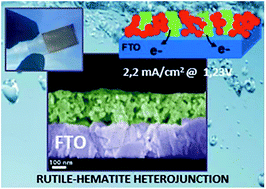Doping of TiO2 as a tool to optimize the water splitting efficiencies of titania–hematite photoanodes†
Abstract
Simple metal oxides such as hematite and titania draw tremendous interest as materials for photoelectrochemical (PEC) water splitting photoelectrodes to produce hydrogen as a clean and sustainable energy carrier. However, the high recombination rates of the photogenerated charges limit their application. Herein, we report on highly efficient and stable composite titania–hematite photoanodes prepared by combining doped TiO2 nanoparticles with amorphous iron oxide and subsequent annealing. Studying the effect of various TiO2 doping strategies, by in-depth structural and chemical characterization, carried out through a multiple technique approach, showed that doping of TiO2 allows subtle tuning of the phase composition, microstructure and surface topography of the photoanodes. When the photoanodes were prepared by combining Ta-doped TiO2 nanoparticles and amorphous iron oxide nanoparticles and subsequently annealed, remarkable photocurrents of up to 2.2 mA cm−2 at 1.23 V in 1 M NaOH under 1.5 AM simulated solar illumination were obtained. The high photocurrents, which were traced back to Ta-doping, were elucidated by rutile-hematite heterojunction energetics and the blocking layer formation. In addition to showing promise for a sustainable and cost-effective generation of an energy carrier, the presented strategies can also be expanded to other material combinations opening doors for new modified semiconductors or heterojunction photoanodes.



 Please wait while we load your content...
Please wait while we load your content...